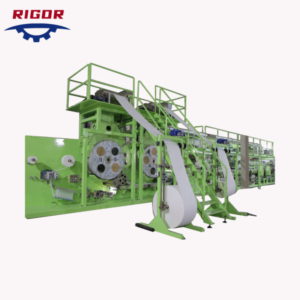How does the nappy making machine handle variations in raw material quality?
Handling variations in raw material quality is essential for ensuring consistent and high-quality output from a nappy making machine.
Here’s how such machines typically manage these variations:
- Material Inspection: Nappy making machines often incorporate material inspection systems to detect variations in raw material quality. These systems may include sensors, cameras, or other inspection devices that assess characteristics such as thickness, weight, moisture content, and visual defects in the raw materials.
- Adjustable Settings: Many nappy making machines feature adjustable settings that allow operators to fine-tune machine parameters in response to variations in raw material quality. For example, adjustable tension controls may be used to accommodate differences in the thickness or elasticity of the materials.
- Material Compatibility: Nappy making machines are designed to accommodate a range of raw material types and qualities. Manufacturers typically provide guidelines or specifications regarding the acceptable quality parameters for each type of raw material used in the machine.
- Material Handling Systems: Advanced material handling systems within the nappy making machine can help compensate for variations in raw material quality. For example, automated feeding systems may adjust feeding rates or tensions to ensure consistent material delivery to the manufacturing process.
- Process Monitoring and Control: Real-time monitoring and control systems are often integrated into nappy making machines to track process parameters and adjust machine settings as needed. These systems can detect deviations from desired conditions and automatically make adjustments to maintain product quality.
- Quality Assurance Protocols: Nappy manufacturers typically implement quality assurance protocols to verify the quality of raw materials before they are used in production. nappy making machine This may include sampling and testing procedures to ensure that materials meet specified quality standards.
- Supplier Relationships: Establishing strong relationships with reliable suppliers is crucial for nappy manufacturers to ensure consistent quality of raw materials. Suppliers may be required to adhere to quality assurance protocols and provide documentation certifying the quality of materials supplied.
- Process Optimization: Continuous process optimization is key to managing variations in raw material quality effectively. Manufacturers may conduct regular evaluations and testing to identify opportunities for improving machine performance and minimizing the impact of material variations on product quality.
Overall, nappy making machines employ a combination of advanced technology, adjustable settings, process monitoring, and quality assurance measures to handle variations in raw material quality and maintain consistent product quality over time.
